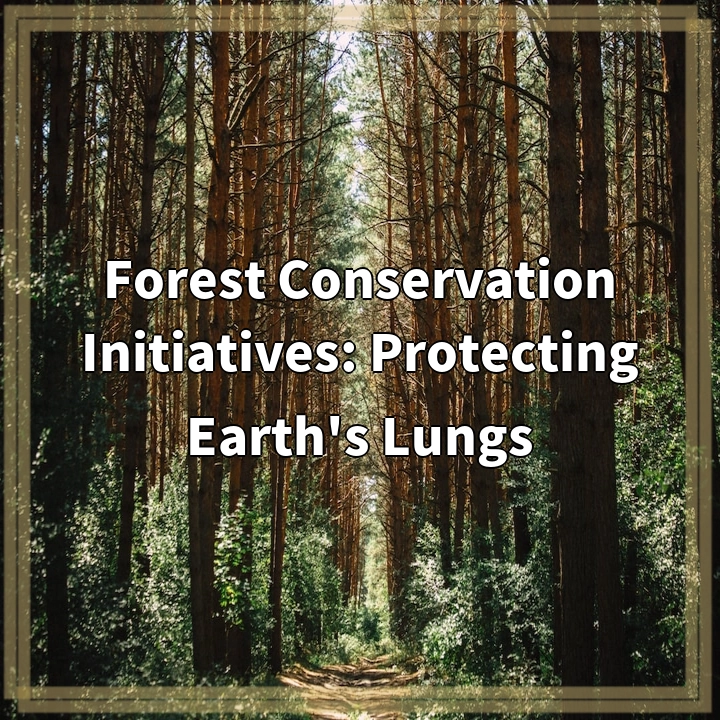
What is Forest Conservation Initiatives: Protecting Earth’s Lungs?
Forest conservation initiatives aim to protect and preserve the world’s forests, which are often referred to as Earth’s lungs. These initiatives recognize the crucial role that forests play in maintaining biodiversity, regulating the climate, and providing numerous ecosystem services. Forests are not only essential habitats for countless plant and animal species, but they also serve as carbon sinks, absorbing and storing significant amounts of carbon dioxide from the atmosphere.
Real-World Problems Associated with Forest Conservation Initiatives
1. Deforestation and illegal logging practices
Deforestation remains one of the most pressing threats to forest conservation initiatives. Large-scale agricultural expansion, unsustainable logging practices, and the conversion of forest areas for infrastructure development are contributing to the rapid loss of global forest cover. Illegal logging, in particular, poses a significant challenge, often driven by economic incentives and ineffective law enforcement.
2. Fragmentation and habitat loss
Forest conservation initiatives face the challenge of mitigating the impacts of habitat loss and fragmentation. Fragmentation occurs when forests are divided into smaller, isolated patches, resulting in reduced biodiversity and limited gene flow among species. Fragmented habitats are more susceptible to invasive species, natural disasters, and the disruption of ecological processes.
3. Climate change and forest degradation
Climate change poses a significant threat to forest conservation efforts. Increases in temperature, changes in precipitation patterns, and extreme weather events can lead to forest degradation and alter the composition and structure of ecosystems. Climate change also puts pressure on vulnerable species and can lead to shifts in species distribution, affecting the overall functioning of forest ecosystems.
4. Unsustainable resource extraction
Unsustainable resource extraction, such as mining and unregulated collecting of timber and non-timber forest products, can have detrimental effects on forest ecosystems. Overexploitation disrupts ecological balances and can result in the loss of important forest species. Forest conservation initiatives aim to promote sustainable harvesting practices and the equitable distribution of benefits derived from forest resources.
5. Lack of funding and political will
Despite the importance of forest conservation, a lack of funding and political will often hinder effective implementation. Forest conservation initiatives require adequate financial resources to support activities such as reforestation, capacity building, and monitoring. Additionally, political commitment and collaboration between governments, organizations, and local communities are essential for long-term success and sustainability.

Solutions to Forest Conservation Challenges
1. Sustainable land use practices
Implementing sustainable land use practices is crucial to address deforestation and illegal logging. This includes promoting responsible agriculture that avoids forest conversion, supporting community-based forestry initiatives, and implementing strict regulations and monitoring mechanisms to combat illegal logging activities.
2. Habitat restoration and connectivity
Restoring degraded forest areas and creating ecological corridors can help counteract habitat loss and fragmentation. Reforestation efforts, along with the creation of protected areas and wildlife corridors, can enhance biodiversity and enable species to move freely between habitats, promoting resilience and ecological balance.
3. Climate change adaptation and mitigation
Adapting to climate change and mitigating its impacts on forests require action on multiple fronts. This includes implementing sustainable forest management practices, enhancing forest monitoring technologies, and supporting community-led initiatives that blend traditional and scientific knowledge in building resilience. Reducing greenhouse gas emissions through sustainable land use practices and forest conservation can also contribute to climate change mitigation efforts.
4. Promotion of sustainable resource management
The promotion of sustainable resource management practices is vital for preventing overexploitation. This involves developing and enforcing regulations that promote responsible resource extraction, engaging local communities in decision-making processes, and encouraging the development of alternative livelihoods that reduce dependence on forest resources.
5. Increased funding and political commitment
Securing adequate funding and political commitment is essential for the success of forest conservation initiatives. This includes mobilizing resources from national and international sources, promoting public-private partnerships, and raising awareness about the economic and ecological value of forests. Fostering strong collaboration between governments, NGOs, local communities, and indigenous groups is also critical to ensure long-term sustainability and success.















